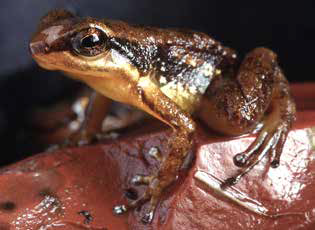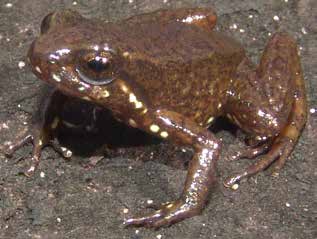
Stefania is a genus of frogs in the family Hemiphractidae. They are native to the highlands of the Guiana Shield in southern Venezuela, Guyana, and adjacent far northern Brazil. Most are restricted to the tepui highlands, but S. evansi also occurs in lowlands. On most mountains there are only 1–2 species from this genus, but five are known from Mount Ayanganna and the neighbouring Mount Wokomung has six species. They are usually found near streams at low levels on branches/leaves or on the ground among vegetation/rocks.

Anomaloglossus breweri is a species of frogs in the family Aromobatidae. It is only known from its type locality, Aprada-tepui in the Bolívar state of southeastern Venezuela. This species was discovered by scientists exploring the inaccessible and remote region of Aprada-tepui. It is a fast-moving frog that lives along creeks and in quiet pools along small streams along the slopes near the cave. The frog is named for Charles Brewer-Carías who collected the type series.
Minyobates steyermarki is a species of frog in the family Dendrobatidae endemic to Cerro Yapacana in southern Venezuela. It is also known by the common names of demonic poison frog, demonic poison-arrow frog, or Yapacana's little red frog. It is monotypic in the genus Minyobates.

Anomaloglossus rufulus is a species of frog in the family Aromobatidae. It is endemic to Venezuela where it is known from a few tepuis in the Chimantá Massif in the Bolívar state.
Tepuihyla luteolabris is a species of frog in the family Hylidae endemic to Venezuela where it can be found on a number of tepui. Its natural habitat is high montane tepui vegetation. Reproduction takes place in rivers.
Pristimantis marahuaka is a species of frog in the family Strabomantidae. It is endemic to the summit of Cerro Marahuaca, a tepui in central Amazonas state, Venezuela. Its natural habitat is tepui shrubland at around 2,450 m (8,040 ft) asl where it is common in the mossy bases of Heliamphora plants.

Stefania breweri, also known as Brewer's carrying frog, is a species of frog in the family Hemiphractidae. It is endemic to Cerro Autana, Venezuela, and only known from a single specimen (holotype). It was named for Venezuelan explorer Charles Brewer-Carías.
Stefania ginesi is a species of frog in the family Hemiphractidae. It is endemic to the Chimantá Massif, Venezuela. Its natural habitats are humid rocky habitats on tepuis. While its range is restricted, it is a common species within its range. It can be found in crevices, caves, on open rock surfaces and adjacent peat bogs, in streams and rivers. Its range overlaps with the Canaima National Park.
Stefania goini is a species of frog in the family Hemiphractidae. It is endemic to Amazonas, Venezuela, and known from Cerro Duida and the nearby Cerro Huachamacari. Its natural habitats are streams on the tops of tepuis. It usually occurs on rocks.
Stefania oculosa is a species of frog in the family Hemiphractidae. It is endemic to the Bolívar state of southern Venezuela and only known from Cerro Jaua, a tepui; it possibly occurs more widely. It was found on rocks in a fast-flowing cascading stream where it co-occurred with Stefania percristata. The known range is within the Jaua-Sarisariñama National Park, and the species is not facing known threats.
Stefania percristata is a species of frog in the family Hemiphractidae. It is endemic to Venezuela and only known from its type locality, Cerro Jaua in Bolívar State. It occurs along streams at the top of the tepui. It is a nocturnal species found on branches of vegetation 0.3–1 m above the ground.
Stefania riae is a species of frog in the family Hemiphractidae. This species is only known from Cerro Sarisariñama, a tepui in the Bolívar State, Venezuela.
Stefania riveroi is a species of frog in the family Hemiphractidae. It is only known from Yuruaní tepui, a tepui on the border of Venezuela and Guyana. Its habitats are subtropical or tropical moist montane forests, subtropical or tropical high-altitude shrubland, rivers and rocky areas.
Stefania schuberti is a species of frog in the family Hemiphractidae. Its natural habitats are subtropical or tropical moist montane forests and rivers.
Stefania tamacuarina is a species of frog in the family Hemiphractidae. It is found in the Sierra Tapirapecó in the Amazonas state of Venezuela as well as in the adjacent Amazonas state of Brazil. The specific name tamacuarina refers to the type locality, a spur ridge north of Pico Tamacuari.
Angasima-tepui, also known as Adanta, Adankasima or Adankachimö, is a tepui in Bolívar state, Venezuela. A relatively isolated peak, both it and nearby Upuigma-tepui lie just south of the vast Chimantá Massif, from which they are separated by the Río Aparurén valley. Amurí-tepui, the closest member of the Chimantá Massif, is only 8 kilometres (5.0 mi) from Angasima-tepui.

Josefa Celsa Señaris is a Venezuelan herpetologist. She has published information about frogs and she has identified new genera and species. Señaris is the director of the La Salle Foundation's Natural History Museum in Caracas.
Jaua-Sarisariñama National Park was located in the Guayana Highlands, within Bolívar State of southeastern Venezuela. It was established in 1978. It has been subsumed within Caura National Park, which was established in 2017.
Cerro Jaua is a tepui in Bolivar State, Venezuela. The mountain has a height of 2395 meters, It was included in Jaua-Sarisariñama National Park which has been subsumed within Caura National Park.
The tepui tree frog is a frog in the family Hylidae, endemic to Brazil and Venezuela. Scientists have seen it between 420 and 1800 meters above sea level.





